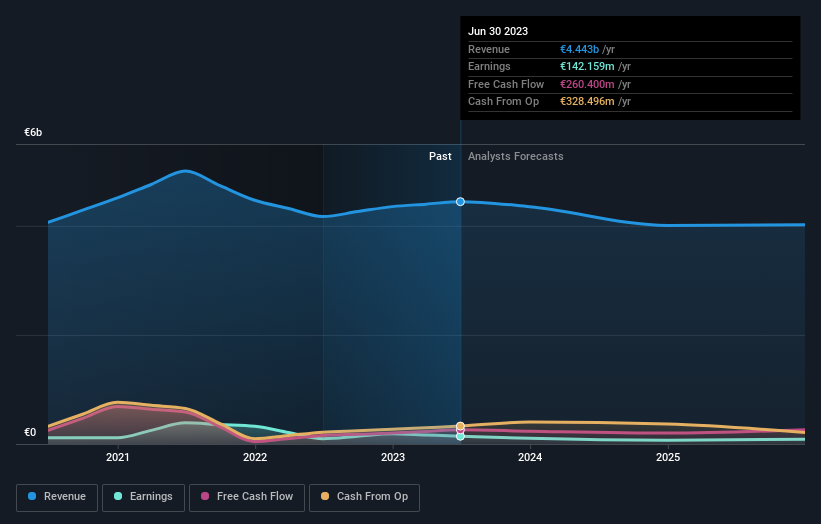Stock Analysis
- France
- /
- Real Estate
- /
- ENXTPA:NXI
Retail investors who have a significant stake must be disappointed along with institutions after Nexity SA's (EPA:NXI) market cap dropped by €100m

Key Insights
- Nexity's significant retail investors ownership suggests that the key decisions are influenced by shareholders from the larger public
- The top 25 shareholders own 44% of the company
- Institutions own 30% of Nexity
To get a sense of who is truly in control of Nexity SA (EPA:NXI), it is important to understand the ownership structure of the business. We can see that retail investors own the lion's share in the company with 56% ownership. Put another way, the group faces the maximum upside potential (or downside risk).
While institutions who own 30% came under pressure after market cap dropped to €840m last week,retail investors took the most losses.
Let's take a closer look to see what the different types of shareholders can tell us about Nexity.
View our latest analysis for Nexity

What Does The Institutional Ownership Tell Us About Nexity?
Many institutions measure their performance against an index that approximates the local market. So they usually pay more attention to companies that are included in major indices.
We can see that Nexity does have institutional investors; and they hold a good portion of the company's stock. This suggests some credibility amongst professional investors. But we can't rely on that fact alone since institutions make bad investments sometimes, just like everyone does. When multiple institutions own a stock, there's always a risk that they are in a 'crowded trade'. When such a trade goes wrong, multiple parties may compete to sell stock fast. This risk is higher in a company without a history of growth. You can see Nexity's historic earnings and revenue below, but keep in mind there's always more to the story.

Hedge funds don't have many shares in Nexity. SAS Rue La Boetie is currently the company's largest shareholder with 6.5% of shares outstanding. The second and third largest shareholders are CM-CIC Asset Management SA and Crédit Mutuel Group, with an equal amount of shares to their name at 5.0%.
On studying our ownership data, we found that 25 of the top shareholders collectively own less than 50% of the share register, implying that no single individual has a majority interest.
Researching institutional ownership is a good way to gauge and filter a stock's expected performance. The same can be achieved by studying analyst sentiments. There are a reasonable number of analysts covering the stock, so it might be useful to find out their aggregate view on the future.
Insider Ownership Of Nexity
The definition of company insiders can be subjective and does vary between jurisdictions. Our data reflects individual insiders, capturing board members at the very least. Company management run the business, but the CEO will answer to the board, even if he or she is a member of it.
I generally consider insider ownership to be a good thing. However, on some occasions it makes it more difficult for other shareholders to hold the board accountable for decisions.
We can report that insiders do own shares in Nexity SA. As individuals, the insiders collectively own €24m worth of the €840m company. It is good to see some investment by insiders, but it might be worth checking if those insiders have been buying.
General Public Ownership
The general public, mostly comprising of individual investors, collectively holds 56% of Nexity shares. This level of ownership gives investors from the wider public some power to sway key policy decisions such as board composition, executive compensation, and the dividend payout ratio.
Private Company Ownership
Our data indicates that Private Companies hold 12%, of the company's shares. It might be worth looking deeper into this. If related parties, such as insiders, have an interest in one of these private companies, that should be disclosed in the annual report. Private companies may also have a strategic interest in the company.
Next Steps:
It's always worth thinking about the different groups who own shares in a company. But to understand Nexity better, we need to consider many other factors. Be aware that Nexity is showing 4 warning signs in our investment analysis , and 2 of those are concerning...
If you would prefer discover what analysts are predicting in terms of future growth, do not miss this free report on analyst forecasts.
NB: Figures in this article are calculated using data from the last twelve months, which refer to the 12-month period ending on the last date of the month the financial statement is dated. This may not be consistent with full year annual report figures.
Valuation is complex, but we're helping make it simple.
Find out whether Nexity is potentially over or undervalued by checking out our comprehensive analysis, which includes fair value estimates, risks and warnings, dividends, insider transactions and financial health.
View the Free AnalysisHave feedback on this article? Concerned about the content? Get in touch with us directly. Alternatively, email editorial-team (at) simplywallst.com.
This article by Simply Wall St is general in nature. We provide commentary based on historical data and analyst forecasts only using an unbiased methodology and our articles are not intended to be financial advice. It does not constitute a recommendation to buy or sell any stock, and does not take account of your objectives, or your financial situation. We aim to bring you long-term focused analysis driven by fundamental data. Note that our analysis may not factor in the latest price-sensitive company announcements or qualitative material. Simply Wall St has no position in any stocks mentioned.
About ENXTPA:NXI
Nexity
Nexity SA operates as a real estate company in Europe and internationally.
Moderate growth potential and slightly overvalued.

